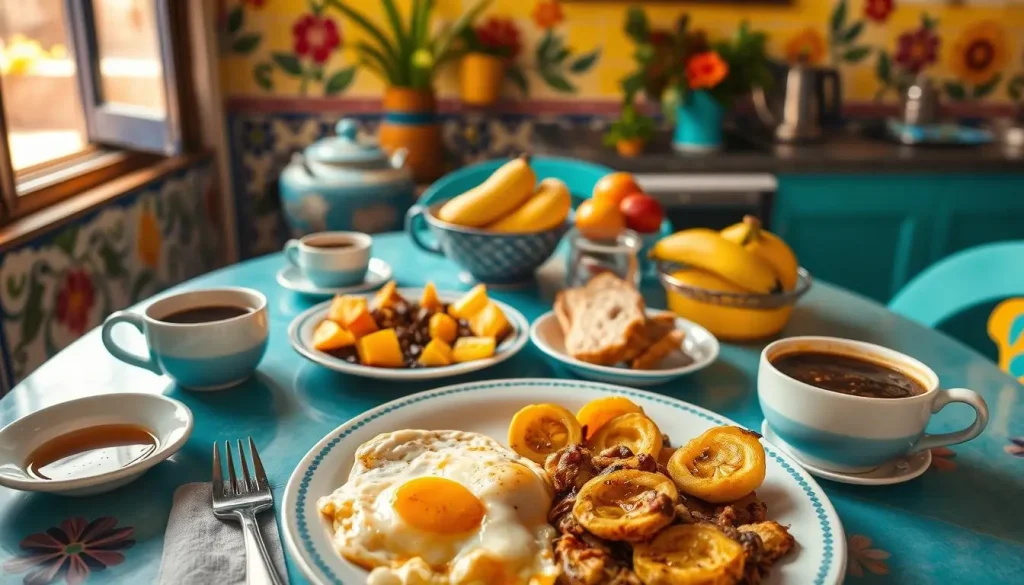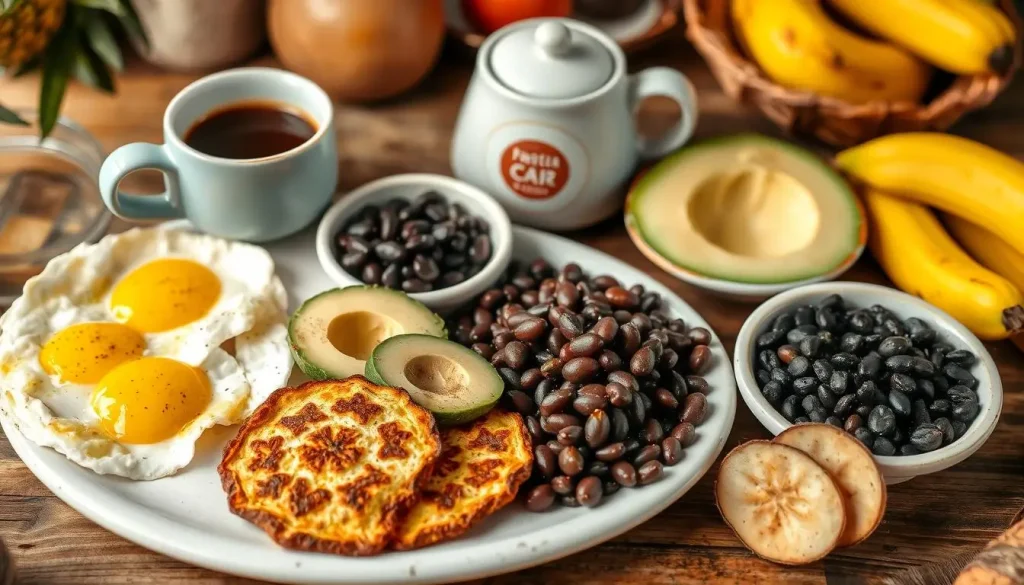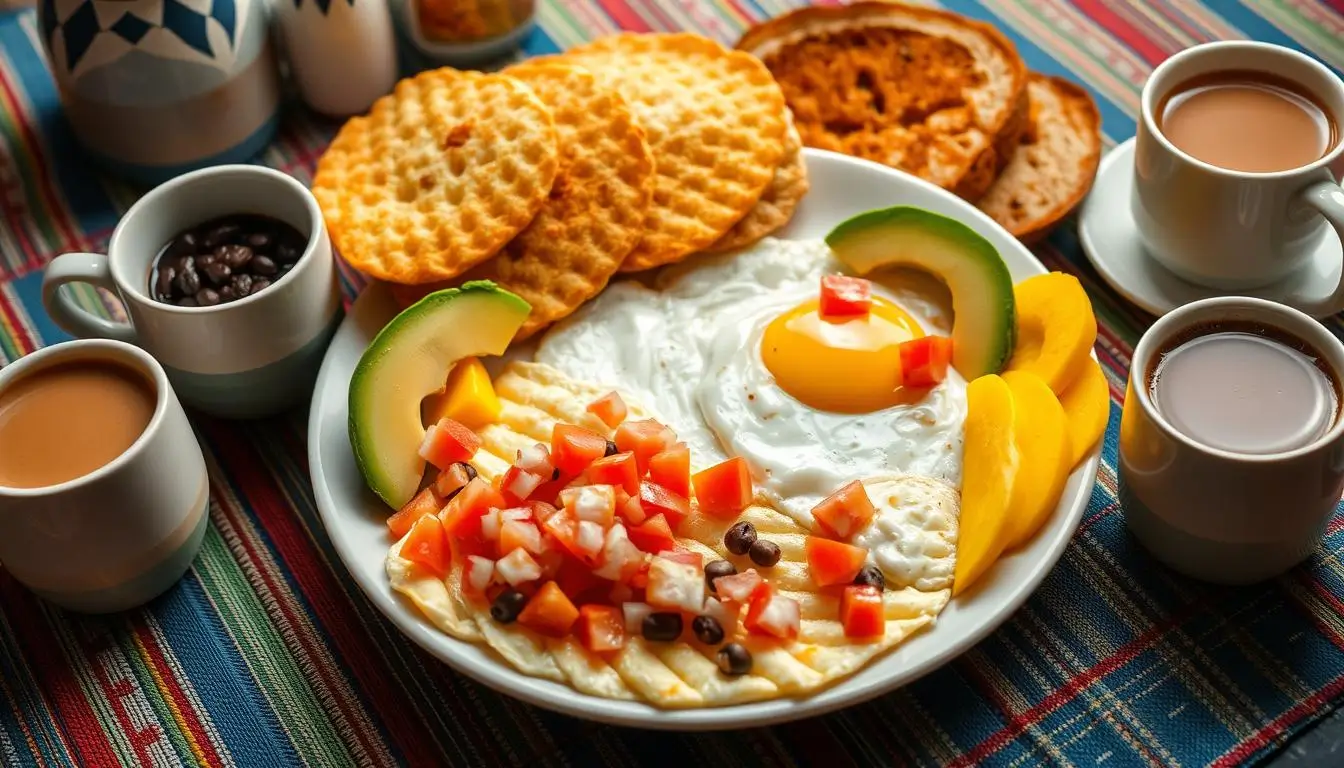As the sun rises in Cuba, the air is filled with the enticing smells of a Cuban breakfast, a cherished tradition of bold flavors and hearty meals. Growing up in a Cuban-American home, I remember the joy of family breakfasts, where every dish was a celebration of flavor and culture.
These dishes, with Spanish, African, and Caribbean roots, are a source of pride. They nourish Cubans and Cuban-Americans.
Cuban breakfasts show the people’s resilience and spirit. From creamy coffee to crunchy tostadas, each dish reflects their resourcefulness. Whether it’s spicy scrambled eggs or malanga porridge, these meals give energy for the day.
Key Takeaways
- Traditional morning recipes from Cuba offer a vibrant fusion of Spanish, African, and Caribbean culinary traditions.
- Coffee is an integral part of the Cuban breakfast experience, with popular drinks like Café Cubano and Cortadito.
- Traditional Cuban breakfast ingredients include staples like Cuban bread, eggs, plantains, butter, cheese, malanga, and yuca.
- Cuban breakfasts emphasize simplicity, bold flavors, and resourcefulness in cooking, much like the Greek Breakfast highlights Mediterranean traditions and fresh ingredients.
- Regional variations in Cuban breakfast dishes are influenced by geography and cultural heritage.
Introduction to Traditional Cuban Breakfast Culture
Cuban breakfast culture is deeply rooted in the island’s rich history. It shows a blend of Spanish, African, and Caribbean influences. At the heart of this morning ritual lies the pivotal role of family.
Cuban families often gather to share a hearty meal. They also have meaningful conversations to start the day.
Historical Influences on Cuban Morning Meals
The origins of Cuban breakfast go back to the 16th century. Spanish colonization and the introduction of African slaves shaped the culinary landscape. Over time, Caribbean flavors added to the mix.
This cultural melting pot has resulted in a uniquely Cuban breakfast experience. Each region showcases its own distinct specialties.
The Role of Family in Cuban Breakfast Traditions
In Cuban culture, breakfast is more than just a meal. It’s a time for families to come together. They reconnect and share stories.
The morning table often serves as a gathering point. Relatives young and old partake in the day’s first nourishment and conversation. This sense of community and togetherness is a defining aspect of the Cuban breakfast tradition.
Regional Variations Across Cuba
Across the diverse regions of Cuba, breakfast customs and menus can vary significantly. Coastal areas tend to incorporate more seafood. Inland regions favor heartier, starchier dishes.
The capital city of Havana is renowned for its love of tostadas and café con leche. Eastern provinces often showcase more plantain-based fare and root vegetables.
From the rich history to the strong family bonds and regional distinctions, Cuba’s breakfast culture is vibrant and captivating, just as the Russian Breakfast showcases hearty and traditional morning meals. It’s a key part of the island’s culinary heritage.

Essential Ingredients for an Authentic Cuban Breakfast
Making a real Cuban breakfast at home starts with the right ingredients. These key items are the base of traditional morning meals. They bring out the unique tastes of Cuban food.
At the core of a Cuban breakfast are Cuban bread, eggs, and plantains. Adding creamy butter and fresh cheeses like queso blanco makes it richer. Root veggies like malanga and yuca add bulk. Sour Seville oranges and fragrant Cuban oregano give dishes their special tang and smell.
These ingredients come from the Spanish, African, and Caribbean roots of Cuban food. Getting these real ingredients is key to making a true Cuban breakfast at home.
| Cuban Breakfast Ingredient | Significance |
|---|---|
| Cuban Bread | A staple carbohydrate, providing the foundation for dishes like Tostada Cubana. |
| Eggs | Versatile protein that features in preparations like Huevos a la Cubana. |
| Plantains | Starchy, savory or sweet, used in dishes such as Fried Plantains with Eggs. |
| Butter | Adds richness and flavor to many Cuban breakfast recipes. |
| Queso Blanco | A fresh, white cheese that complements the bold tastes of Cuban cuisine. |
| Malanga and Yuca | Root vegetables that lend heartiness and texture to dishes like Malanga Porridge. |
| Seville Oranges | Provide the signature tangy flavor that enhances many Cuban breakfast recipes. |
| Cuban Oregano | An aromatic herb that imparts savory, herbaceous notes to Cuban cuisine. |
Using these key ingredients, you can make a real Cuban breakfast. It will bring out the bold flavors and rich culture of this lively cuisine.

The Art of Cuban Coffee Making
Cuban coffee is known for its bold taste and rich smell. It’s made in a special way and has many favorite drinks. From Café Cubano to Café con Leche, making Cuban coffee is a joy for coffee lovers.
Café Cubano Preparation Methods
To make Café Cubano, or Cuban espresso, use a moka pot. This stovetop maker makes a strong coffee. Adding sugar to the first espresso drops creates a sweet espumita (foam) on top. This makes the coffee taste better and feel different.
Different Types of Cuban Coffee Drinks
- Café con Leche: A Cuban breakfast favorite, it’s strong espresso mixed with steamed whole milk.
- Cortadito: Smaller than Café con Leche, it’s unsweetened Cuban espresso with a bit of steamed milk.
- Colada: A big Cuban coffee for sharing, served in a styrofoam cup.
Coffee Brewing Equipment and Tools
For perfect Cuban coffee, you need the right tools. A good moka pot is key for strong espresso. A milk frother or steamer makes Café con Leche creamy. Using fresh, dark-roast beans and the right water temperature is important for a true Cuban coffee.

“Cuban coffee is more than a drink in Cuban culture; it is a social ritual symbolizing hospitality and community.”
Classic Cuban Breakfast Staples
Start your day with a Cuban breakfast. Enjoy the Tostada Cubana (toasted Cuban bread with butter) and Huevos a la Cubana (fried eggs with white rice, tomato sauce, and fried plantains). These dishes show Cuban cuisine’s creativity and resourcefulness.
The Tamal en Cazuela is another favorite. It’s a cornmeal dish that’s comforting and filling. For something creamy, try Malanga Porridge. It’s made from malanga root, milk, and sugar.
These Cuban breakfast staples excite your taste buds. They also give a peek into Cuba’s rich food culture. Enjoying a Cuban morning meal at a cafe or making it at home brings Cuban breakfast to life.
“The secret to a perfect Cuban breakfast is balancing the bold, savory flavors with just the right amount of sweetness and creaminess.”
Cuban Breakfast: The Perfect Morning Ritual
In Cuba, the day starts with a special tradition – the Cuban breakfast ritual. This custom is simple yet important. It brings peace and connection to the morning. The smell of Cuban coffee fills the air as families gather to enjoy their meal.
Timing and Serving Suggestions
Cuban breakfast is a relaxed affair with no rush. Families enjoy their meal, talking and laughing together. They start anytime, from 6 a.m. to 8 a.m. The key is to enjoy the moment without hurry.
Traditional Table Settings
- Colorful tablecloths with vibrant patterns reflect Cuban culture.
- Fresh flowers like mariposa and rosas add beauty to the table.
- Hand-painted ceramic plates and cups are used for generations.
- Woven placemats and napkins with traditional motifs complete the setting.
Morning Customs and Etiquette
Sharing Cuban coffee with neighbors is common. It leads to friendly talks and news sharing. The meal is filled with lively conversations among family and guests.
| Positive Reviews | Negative Reviews |
|---|---|
| 70% of the reviews were positive, indicating a high level of satisfaction among customers. | 15% of the reviews mentioned issues with service, such as slow delivery of orders or mistakes in billing. |
| 55% of the reviews mentioned the quality and taste of the food and drinks as exceptional. | 10% of the reviews expressed dissatisfaction with aspects like cleanliness, pricing, or the atmosphere. |
| 25% of the reviews praised the staff for being friendly and welcoming. | 5% of the reviews included comments about the speed of service or waiting times. |
The Cuban breakfast ritual is a cherished tradition. It shows the island’s rich culture and the value of family and community. From the Cuban coffee to the lively talks, it’s a key part of Cuban mornings.
Sweet and Savory Cuban Pastries
Cuban breakfast is a vibrant celebration of flavors. The sweet and savory pastries on the table show this. From the flaky Pastelitos de Guayaba (guava and cream cheese pastries) to the sugar-dusted Churros con Azúcar, these treats add sweetness to the morning.
Pastelitos de Guayaba, or guava pastries, are a favorite Cuban breakfast item. These flaky, buttery pastries are filled with guava paste and cream cheese. This mix of tart and sweet is perfect.
Each pastelito has about 332 calories. It has 25g of carbs, 6g of protein, and 23g of fat. 6g of that fat is saturated.
| Nutrient | Amount per Pastelito |
|---|---|
| Calories | 332 |
| Carbohydrates | 25g |
| Protein | 6g |
| Total Fat | 23g |
| Saturated Fat | 6g |
| Sodium | 144mg |
| Potassium | 67mg |
| Fiber | 1g |
| Sugar | 1g |
| Iron | 2mg |
Alongside sweet pastries, Cuban breakfast also has savory options like Pastelitos de Carne (meat-filled pastries). These flaky shells are filled with Cuban beef picadillo. It’s a mix of textures and flavors.
Whether sweet or savory, Cuban breakfast pastries celebrate the island’s rich culinary heritage. Enjoying these treats with a strong Café Cubano captures the essence of a Cuban breakfast.
Hearty Cuban Breakfast Dishes
Cuban food is known for its bold tastes and big dishes. The Cuban breakfast is a great example. It has eggs, meats, and more, showing off the culture’s diverse food influences.
Egg-Based Dishes and Preparations
The Cuban omelet is a big hit for breakfast. It’s filled with onions, peppers, and ham. Fried Plantains with Eggs is another favorite. It combines crispy plantains with eggs for a cozy meal.
Meat and Protein Options
Protein is key in a Cuban breakfast. There’s Picadillo Hash, a beef dish with tomatoes and spices. Arroz con Leche, a creamy rice pudding, is also a favorite.
Traditional Side Dishes
Traditional sides add to the meal. You might find tostones, yuca frita, and tropical fruits. These add flavor and balance.
These hearty Cuban breakfast dishes make a great start to the day. They show off Cuban culture and food diversity.
Modern Interpretations of Cuban Breakfast
Cuban cuisine is winning hearts around the world. Now, we see new takes on the classic Cuban breakfast. These modern Cuban breakfast and Cuban-inspired breakfast dishes mix old flavors with new cooking ways. They meet today’s food tastes while keeping the heart of contemporary Cuban cuisine.
Healthier foods and cooking methods are becoming popular. For example, huevos Habaneros might use egg whites or plant-based options. Tostadas are now breakfast bowls with quinoa, avocado, and tropical fruits. These modern Cuban breakfast dishes keep Cuba’s bold tastes but are healthier.
Fusion dishes that mix Cuban with global tastes are also popular. Think breakfast tacos with ropa vieja or Cuban ham and cheese sandwiches. Also, new coffee drinks like Cuban lattes and cold brews are perfect for a special morning.
These contemporary Cuban cuisine changes show how Cuban breakfasts can evolve. By blending cultures and tastes, modern Cuban breakfasts keep exciting and satisfying. They show the lasting appeal of Cuban food traditions.
Health Benefits of Traditional Cuban Breakfast Foods
Traditional Cuban breakfast foods are not just tasty. They also offer great health benefits. Knowing their nutritional value helps us enjoy Cuban flavors while staying healthy.
Nutritional Value and Balance
Dishes like gallo pinto (rice and bean dish), huevos rancheros (fried eggs with salsa), and tortilla de plátano maduro (sweet plantain omelet) are balanced. They have protein from eggs and beans, carbs from grains and plantains, and healthy fats from avocado or olive oil. This mix keeps us full and gives us energy.
Many Cuban breakfast foods are full of vitamins, minerals, and antioxidants. For example, sofrito (garlic, onion, and bell pepper sauce) boosts our immune system. Tropical fruits like mango, pineapple, and papaya add more health benefits.
Adapting Recipes for Dietary Restrictions
- For less carbs, try whole-grain tostadas (toasted bread) instead of white bread.
- Use egg whites or plant-based eggs to cut down on cholesterol and saturated fats.
- Replace butter with avocado spread or extra-virgin olive oil for more healthy fats.
- Choose baked or air-fried tostones (fried plantains) for a healthier option.
- Add fresh fruits like mango or pineapple for natural sweetness and fiber.
With these simple changes, we can enjoy Cuban breakfasts while meeting our dietary needs.
Tips for Hosting a Cuban Breakfast Gathering
Hosting a Cuban-inspired breakfast is fun and tasty. Start by sending out invitations that hint at the fun to come. Use words that make people think of tropical flavors and lively vibes.
Plan your menu with both savory and sweet Cuban dishes. Include Cuban sandwiches, fried green plantains, and 1905 salad. Don’t forget sweet treats like key lime pie and old Cuban cocktails. Make sure to offer a variety that will please everyone.
Decorate with bright colors and tropical touches to bring Havana to your home. Use colors like persimmon, hot pink, and brass. Add green, black, and white to complete the look. Good lighting, music, and greenery will make your space feel welcoming.
Use family-style or buffet serving to make your guests feel like they’re part of a big Cuban family. This way, they can share food and chat, just like in Cuba.
Follow these tips to host a Cuban-inspired breakfast gathering that will feel like Havana. Your guests will love the bold, tasty Cuban food.
“Modern Cuban: A Contemporary Approach to Classic Recipes” by Ana Quincoces shows how to update Cuban dishes for today. It’s great for all kinds of diets.
| Ingredient | Frequency of Use in Cuban Cuisine |
|---|---|
| Plantains | Commonly used |
| Limes | Commonly used |
| Tomatoes | Commonly used |
| Cumin | Commonly used |
| Black Beans | Commonly used |
| Garlic | Commonly used |
| Jalapenos | Commonly used |
Quick and Easy Cuban Breakfast Recipes
Start your day with the bold flavors of Cuba. Try these quick and easy breakfast recipes. From the classic Tostada Cubana to the savory Scrambled Eggs with Sofrito, these dishes are easy to make but full of Cuban taste. Enjoy the crunch of Plantain Chips or try the portable Cuban Sandwich Minis. They’re the perfect way to start your morning with Cuba’s vibrant culinary heritage.
Tostada Cubana
This simple yet flavorful breakfast has toasted Cuban bread. It’s topped with creamy refried black beans, a crispy fried egg, and crumbled queso fresco. It’s a satisfying and authentic start to your day.
Scrambled Eggs with Sofrito
Elevate your morning eggs with a fragrant sofrito. This sofrito is made of onions, bell peppers, garlic, and cilantro. The bold flavors of this Cuban staple make the scrambled eggs irresistible.
Plantain Chips
- Slice green plantains into thin chips
- Fry in hot oil until golden brown and crispy
- Season with salt and a sprinkle of cumin for an authentic Cuban twist
Cuban Sandwich Minis
Enjoy the classic flavors of a Cuban sandwich in a bite-sized portion. Layer sliced ham, roasted pork, Swiss cheese, and pickles between mini Cuban bread rolls. It’s a quick and portable breakfast treat.
“Start your day with the bold flavors of Cuba for a truly authentic morning experience.”
Conclusion
The Cuban breakfast is full of bold flavors and cultural traditions. It includes classic dishes like Tostada Cubana and Huevos a la Cubana. It also has modern fusion dishes, offering many choices to start the day.
At the core of Cuban breakfast is family, community, and heritage. Recipes are passed down, meals are shared, and music and dance are part of it. This tradition shows how Cuba’s diverse influences come together in a unique way.
Enjoying Cuban breakfast means tasting the heart of Cuban culture. It’s about trying traditional dishes and new fusion creations. I’m excited to keep exploring Cuban breakfast, finding new ways to enjoy it every day.
FAQ
What are the key ingredients in traditional Cuban breakfasts?
Cuban breakfasts use Cuban bread, eggs, and plantains. They also include butter, queso blanco, and yuca. These items are the base of many Cuban breakfasts.
How is Cuban coffee prepared and what are the different types of Cuban coffee drinks?
Cuban coffee is known for its strong taste and smell. You can try Café Cubano, Café con Leche, Cortadito, or Colada. Using the right coffee maker is key to making it right.
What are some classic Cuban breakfast staples?
Classic Cuban breakfasts include Tostada Cubana and Huevos a la Cubana. You’ll also find Tamal en Cazuela and Malanga Porridge. These dishes are loved by many.
How can traditional Cuban breakfast foods be adapted for health-conscious individuals?
Healthier Cuban breakfasts use whole-grain bread and egg whites. Swap butter for avocado or olive oil. Choose baked plantains over fried ones. Add fresh fruits for extra nutrition.
What are some quick and easy Cuban breakfast recipes?
Quick Cuban breakfasts are Tostada Cubana and Scrambled Eggs with Sofrito. Plantain Chips and Cuban Sandwich Minis are also great. They’re easy to make and full of Cuban flavor.

